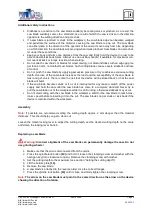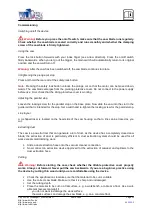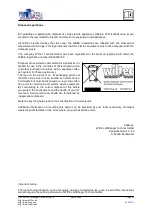
Commissioning
Switching on/off the device
Warning!
Before you press the on/off switch, make sure that the saw blade runs regularly.
Check whether the saw blade is seated correctly and runs smoothly and whether the clamping
screw of the saw blade is firmly tightened.
Using the saw
Press the lock button forwards with your index finger (see arrow direction). Press the on/off switch
firmly backwards. When you let go of the trigger, the main switch will automatically return to its original
position and the saw will turn off.
Warning:
After the saw has been switched off, the saw blade continues to rotate.
Untightening the plunge cut stop
Press and hold the rear end of the safety-lock button.
Note:
Pressing the safety lock button unlocks the plunge cut so that the motor can be moved down-
wards. The saw blade emerges from the pivoting protective cover. Do not connect to the power supply
before use. First, check that the tilting protective cover is working.
Adjusting the parallel stop
Loosen the locking screw for the parallel stop on the base plate. Now slide the saw into the slot in the
guide rail that is intended for the stop. Set a width and re-tighten the locking screw for the parallel stop.
Line layout
A V-shaped laser is located on the head side of the saw housing so that a line can be traced as you
cut.
Extracting dust
The saw is a powerful tool that can generate a lot of dust. As the device has a completely closed saw
blade, the extraction of dust is particularly efficient. A dust extraction system should be used for all
work except small trimming work.
1. Slide a dust extraction hose onto the vacuum cleaner connection.
2. Now connect an extraction device approved for the extraction of sawdust and splinters to the
dust extraction hose.
Cutting
Warning!
Before starting the saw, check whether the tiltable protective cover properly
works. Always cut forward. Never pull the saw backwards. If you are a beginner, practice using
the device by cutting thin wood until you are comfortable using the device.
Check the specifications to make sure that the material to be cut is suitable.
Use the correct saw blade. Make sure that it is sharp and undamaged.
Set the cutting depth.
Place the material to be cut on a flat surface, e. g. a workbench, a table or a floor. Use a suit-
able mat (excess material) if
◦
you do not want to damage the work surface;
◦
the work surface can damage the saw blade, e. g. on a concrete floor.
© by WilTec Wildanger Technik GmbH
Item 62554
Page 10
http://www.WilTec.de
http://www.aoyue.eu
04 2021
-1































